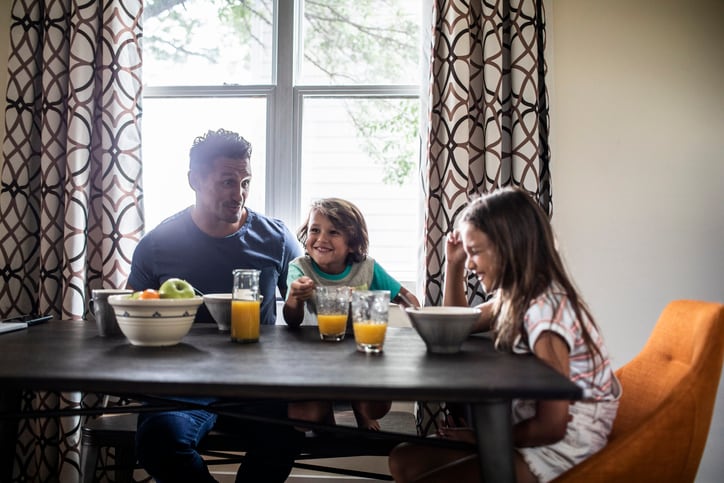One of the toughest parts of back-to-school season is trading in the light, lazy days of summer for a school year schedule wound tight. With school comes stricter wake-up times and packed schedules — not to mention a whole host of new rules and obligations and expectations to juggle.
Such a big change can be jarring for kids and parents. Thankfully, there are a few things you or your nanny or sitter can do to make the transition smooth for everyone.
1. Start early and go slow
School is probably the last thing you want to think about in July, but going from summer mode to school mode takes time. Begin the transition process a few weeks before school starts, taking care to make changes little by little to avoid a shock to the system. The first step to transitioning from summer to school: Talk about it.
“Any time I can casually bring it up, I talk to my kids a lot about what they’re looking forward to, which friends they’re excited to see, what they’re worried about and how to potentially deal with what they’re worried about,” says Kayla Nordgaard, a mom of three from South Dakota.
If your child is sad that summer is over, for example, brainstorm summer activities you can still do throughout the school year, or plan a weekend getaway in the fall to a favorite lake or campground.
2. Sync up sleep schedules
If summer mornings are lazy affairs in your house, mornings during the school year can feel downright frazzling. The kids are tired. You’re tired. It’s hard on everyone involved. Avoid the back-to-school morning chaos by getting your family’s sleep schedule back on track early.
“In our house, summer bedtime is always a little later, but years ago it was a struggle to get back into the school schedule,” says Erin Ollila, a mom in the Boston area. “Now, about one to two weeks before school begins, we move bedtime earlier, which naturally makes morning wake-ups happen earlier. Once the first day arrives, everyone’s feeling ready and not groggy.”
“Now, about one to two weeks before school begins, we move bedtime earlier, which naturally makes morning wake-ups happen earlier. Once the first day arrives, everyone’s feeling ready and not groggy.”
ERIN OLLILA, MOM
3. Ease into a routine
Making the shift a gradual one is key. As many parents know from adjusting to daylight saving time, kids’ bodies and brains don’t just fall asleep because the clock says it’s time. There’s an internal rhythm at play that needs to be nudged a little at a time. Slowly transitioning to an earlier bedtime and wake-up time is especially important for adolescents, whose biology naturally steers them toward a later sleep schedule.
“Teens generally go to bed later than young kids and even adults; however, they still need eight to 10 hours of sleep each night,” says Yolanda Evans, an adolescent medicine physician at Seattle Children’s Hospital.
A teen who goes to sleep at 4 a.m. in the summer will have a difficult time switching to a 10 p.m. bedtime for the school year, she says, because the brain isn’t ready to go to sleep. That could mean a lot of tossing and turning until they are finally able to drift off — only to wake up a few short hours later, completely exhausted. For these teens (and all sleep-deprived kids), it can be extremely difficult to learn, focus or control their moods or behavior. The best way to ensure kids get a solid 10 hours of sleep a night, Evans says, is to establish a routine throughout the summer and especially in the four to six weeks leading up to school.
“Teens generally go to bed later than young kids and even adults; however, they still need eight to 10 hours of sleep each night.”
DR. YOLANDA EVANS, ADOLESCENT MEDICINE PHYSICIAN
Tips for moving up bedtime:
- Stick to a routine. Have a consistent bedtime routine, where kids do the exact same thing every night before bed. For instance: bath, then teeth-brushing, then book, then lights out. The brain starts to connect this routine with sleep, so when you go through the steps, it sends out chemicals that help kids fall asleep faster and more reliably.
- Slowly change the time. Move up bedtime by only five to 10 minutes each night. As long as you’re going through the bedtime routine, your child’s brain likely won’t care that it’s a few minutes ahead of schedule. But try not to move bedtime up too much, too soon or your child won’t be tired.
- Ditch the screens. Turn off screens one to two hours before bed. Your kids (teens in particular) might put up a fight, but the light from screens (like TVs, smartphones, tablets and computers) acts like an artificial sun, confusing the brain into thinking it’s still daytime. Turning off the devices and keeping them out of the bedroom can mean more and higher-quality sleep.
- Avoid any caffeine in the afternoon. Things like iced tea (made of black or green tea), sodas and chocolate can contain caffeine, a stimulant that keeps the body awake. Kids should try to avoid these things anyway, but it’s especially important to steer clear of them within a few hours of bedtime.
Most school-age kids have a predictable routine during the school year. They know when class starts, when lunch time is and when they get to go home. It’s an important part of how schools and teachers maintain order, get through curriculum and keep anxieties at bay. After all, if roughly the same sequence of events happens the same way every day, even really young kids know what to expect and what is expected of them.
“School is a highly structured environment,” says Rachel Tjaden, an elementary school teacher from Minnesota. “We do everything based on time schedules, and while there is wiggle room in my class, we always have the same morning start, lunch time (and) dismissal.”
Come summer, however, that schedule often goes out the window, along with the alarm clock and set mealtimes. Tjaden encourages parents or the nanny or sitter to establish a routine at least a few weeks before school begins to ease kids back into a more rigid environment. While ideally that routine would match that of the school’s, she acknowledges that’s not always practical.
“Even a lunch schedule would help if it’s possible for parents to get an idea of when their children eat [at school],” Tjaden says.
You can still be spontaneous and flexible — after all, it’s summer! — but try to get back to the routine as soon as possible. For example, if you decide to do something different, like venture to the neighborhood pool or have a playdate in the morning, make every effort to eat lunch at the regular time, and finish out the day according to your established routine so a small disruption doesn’t derail the whole day.
Start by tweaking your wakeup schedule, then establish set meal times and slowly (every few days or so) fill in the gaps in your routine. By the end of summer, your routine could look something like this:
Sample summer routine:
|
Start time |
Activity |
|
7 a.m. |
Wake up and get ready for the day |
|
7:30 a.m. |
Eat breakfast |
|
8 a.m. |
Household chores |
|
9 a.m. |
Free play |
|
11 a.m. |
Prepare lunch together |
|
11:30 a.m. |
Eat lunch |
|
12 p.m. |
Clean up/wash dishes |
|
12:30 p.m. |
Quiet time (reading or nap) |
|
2 p.m. |
Snack |
|
2:30 p.m. |
Individual activities |
|
5:30 p.m. |
Prepare dinner together |
|
6 p.m. |
Eat dinner as a family |
|
6:30 p.m. |
Clean up/wash dishes |
|
7 p.m. |
Family activities |
|
8 p.m. |
Get ready for bed |
|
8:30 p.m. |
Lights out |
4. Engage in structured activities
By having some structured activities during the summer, you’ll help your kids get used to the idea of following instructions, accomplishing specific tasks and working under the clock — just like they will at school.
Structured activities could include academic tasks — like completing a set number of workbook pages each day — but they don’t have to. One example could be asking your children to build something, like a birdhouse or vegetable garden. Over the course of several days, your kids decide what to make and what they need to make it, gather the necessary materials, put them all together, decorate their object (if applicable) and put it in its permanent home.
Another example could be to tap into a child’s love of make-believe by playing “school.” Your child could pretend to be a teacher, and for a set time each day, they “teach” you, their nanny or sitter or a sibling something they learned last school year. This has the added benefit of helping them get into the mindset for a classroom setting and review old material they might have forgotten over summer.
Other structured activities could include:
- Creating a specific art project or craft.
- Planning and preparing a meal, snack or dessert.
- Participating in a step-by-step activity, like an online tutorial.
- Building and going through an obstacle course.
- Making a unique gift for their new teachers.
5. Check in with teachers.
Talking with your children’s teachers before school starts is a great way to get the details on what to expect, especially regarding routine.
“Parents and teachers are teammates in education,” Tjaden says. “The more we can communicate, the easier our jobs can be.”
She recommends taking advantage of opportunities where parents can meet with the teachers before school starts. Teachers are typically happy to share information or make specific suggestions to help kids get ready for their classroom.
Sample questions to ask your child’s teacher at a back-to-school event:
- What is your class schedule?
- What specific things can we start working on now at home to get my child ready for your class?
- What is the best way to communicate with you during the school year? And will you be able to provide updates on how my child is transitioning?
- What are some topics you’ll be covering this year that might get my child excited about coming back?
- What rules do you have for your class that we might want to reinforce or talk about at home?
- What can we as parents do to help you this school year?
6. Recognize that change is hard
Even after doing all of the above, the transition to school can still be full of anxiety. That’s because no matter how hard you try to establish good routines and sleep schedules, being home all summer is very different from being in school.
“The transition to school can be exciting but tough,” Evans says. Her daughter recently finished kindergarten, and “as excited as she was to make friends and get to know her teacher, learning a new building, new rules and thinking all day was challenging.”
What helped her daughter most, she says, was sticking to her routine.
“Having a consistent routine at home meant she knew what to expect after school was over and that home was a stable, safe space,” Evan says. “The routine helps kids get enough sleep to think well, and eating consistently is important for thinking, growth and development.”






